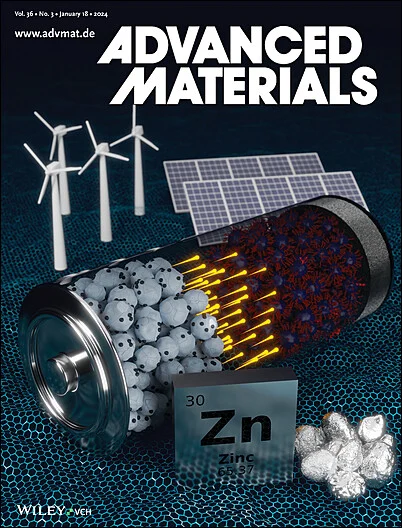Rational Design of High-Entropy Garnet Electrolytes via Computational Screening for Stable Lithium Interfaces in All-Solid-State Batteries.
IF 26.8
1区 材料科学
Q1 CHEMISTRY, MULTIDISCIPLINARY
引用次数: 0
Abstract
All-solid-state lithium metal batteries offer enhanced safety and energy density by replacing flammable liquid electrolytes with solid-state electrolytes (SSEs). High-entropy (HE) SSEs, leveraging multi-principal-element compositions, present a vast design space to achieve exceptional ionic conductivity and electrochemical stability. However, the chemical complexity of HE SSEs introduces challenges in interfacial instability with lithium metal anodes due to the unavoidable inclusion of reactive elements. While conventional garnet-type SSEs are considered stable, it is revealed that five HE garnets (HE-LLZOs) undergo corrosion and partial dissolution upon lithium contact. Here, a rational design strategy is introduced to stabilize HE-LLZO by combining thermodynamic assessments of interfacial reactivity with targeted compositional engineering. Through systematic exploration of element-specific degradation mechanisms, selection criteria for lithium-compatible principal elements are established. Guided by computational screening, unstable dopants are excluded (e.g., Nb, Mo, W, Cr, Bi) that drive interfacial degradation and synthesize a novel HE-LLZO (Li6.6La3Zr0.4Sn0.4Hf0.4Sc0.2Ta0.6O12) that exhibits high ionic conductivity (3.69 × 10-4 S cm-1) and stable cycling over 2,500 h. X-ray photoelectron spectroscopy confirms the interfacial stability of Zr, Sn, and Ta while identifying Nb as a destabilizing element. This work provides an integrated computational-experimental framework for understanding element-property relationships in HE oxides, advancing durable SSEs design.基于全固态电池稳定锂界面计算筛选的高熵石榴石电解质的合理设计。
全固态锂金属电池通过用固态电解质(sse)取代易燃液体电解质,提高了安全性和能量密度。利用多主元素组成的高熵(HE) ssi为实现优异的离子电导率和电化学稳定性提供了广阔的设计空间。然而,由于不可避免地包含活性元素,HE sse的化学复杂性给其与锂金属阳极的界面不稳定性带来了挑战。虽然传统的石榴石型sse被认为是稳定的,但发现五种HE石榴石(HE- llzos)在锂接触时发生腐蚀和部分溶解。本文提出了一种合理的设计策略,通过结合界面反应性的热力学评估和针对性的组分工程来稳定HE-LLZO。通过对元素特定降解机制的系统探索,建立了锂相容主元素的选择标准。在计算筛选的指导下,排除了驱动界面降解的不稳定掺杂剂(如Nb, Mo, W, Cr, Bi),合成了具有高离子电导率(3.69 × 10-4 S cm-1)和2500 h稳定循环的新型HE-LLZO (Li6.6La3Zr0.4Sn0.4Hf0.4Sc0.2Ta0.6O12)。x射线光电子能谱证实了Zr, Sn和Ta的界面稳定性,同时确定Nb为不稳定元素。这项工作为理解HE氧化物中的元素-性质关系提供了一个集成的计算-实验框架,促进了耐用sss的设计。
本文章由计算机程序翻译,如有差异,请以英文原文为准。
求助全文
约1分钟内获得全文
求助全文
来源期刊

Advanced Materials
工程技术-材料科学:综合
CiteScore
43.00
自引率
4.10%
发文量
2182
审稿时长
2 months
期刊介绍:
Advanced Materials, one of the world's most prestigious journals and the foundation of the Advanced portfolio, is the home of choice for best-in-class materials science for more than 30 years. Following this fast-growing and interdisciplinary field, we are considering and publishing the most important discoveries on any and all materials from materials scientists, chemists, physicists, engineers as well as health and life scientists and bringing you the latest results and trends in modern materials-related research every week.
 求助内容:
求助内容: 应助结果提醒方式:
应助结果提醒方式:


